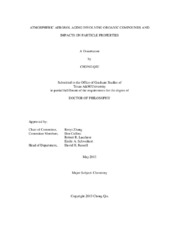| dc.description.abstract | In the first part of this dissertation, we study the aging of soot, a representative type of primary aerosols, in the presence of OH-initiated oxidation products of toluene. Monodisperse soot particles are introduced into an environmental chamber where toluene is oxidized by OH radicals. The variations in soot particle properties are simultaneously monitored, including particle size, mass, organic mass faction, hygroscopicity, and optical properties. The changes in particle properties are found to be largely governed by the thickness of the organic coating that is closely related to reaction time and initial reactant concentrations. Derived from particle size and mass, the effective density increases while dynamic shape factor decreases as the organic coating grows, suggesting a compaction of the soot morphology. As the organic coating grows, the particles become more hygroscopic and have enhanced light scattering and absorption.
The second part discusses the potential reactions between amines and some aerosol constituents and alteration of aerosol properties. The reactions between alkylamines and ammonium sulfate/bisulfate have been studied using a low-pressure fast flow reactor coupled to a mass spectrometer at 293 K. Alkylamines react with ammonium sulfate/bisulfate to form alkylaminium sulfates, suggesting the existence of alkylaminium salts in particle phase. We have extended our study to characterize the physicochemical properties of alkylaminium sulfates. The hygroscopicity, thermostability, and density of five representative alkylaminium sulfates have been measured by an integrated aerosol analytical system. All alkylaminium sulfate aerosols show monotonic size growth when exposed to increasing relative humidity. Mixing ammonium sulfate with alkylaminium sulfates lowers the deliquescence point corresponding to ammonium sulfate. Alkylaminium sulfates are thermally comparable to or more stable than ammonium sulfate. The densities of alkylaminium sulfate particles are lower than that of ammonium sulfate.
Our results suggest that the organic compounds can effectively alter the composition and properties of atmospheric aerosols, considerably influencing the impacts of aerosols on air quality, climate forcing, and human health. | en |


